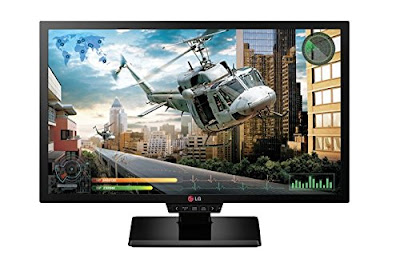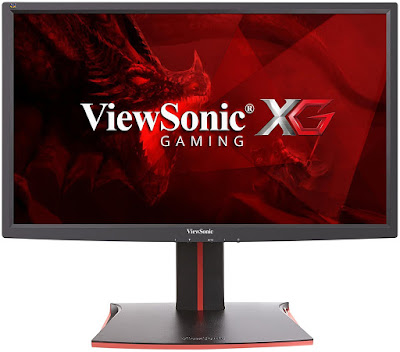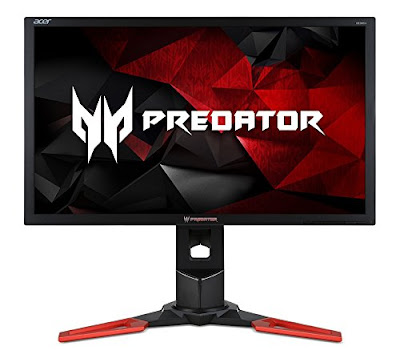Now that you have an overview of monitor technology and the terms that are frequently used, this monitor buying guide will list the best gaming monitors in 2017 and explain the practical considerations you need to make when choosing the best monitor that is right for you. The best gaming monitor may not be ideal for someone using it for work to improve productivity. In the end, we truly believe that the best monitor is one that fits your needs, your computer's capabilities and your budget.
Choosing your Monitor's resolution and refresh rate
Here's a refresher on Monitor resolutions and refresh rates. A monitor's resolution is just the number of pixels on the screen. The Refresh Rate of a monitor is the number of times per second that the monitor draws a new image, in order to display a moving image, and is measured in Hertz (Hz). You may also have seen the term Frames per Second (fps). Unlike the Refresh Rate, this is the number of frames that your video card is spitting out per second.So what is the best monitor resolution and refresh rate? Well, it depends on your GPU and what games you intend to play.
Let's start with how to choose a monitor meant for gaming. If you intend to buy a gaming monitor, the most common resolutions and refresh rates are:
- 1080p @ 60hz (1920 x 1080)
- 1080p @ 144hz (1920 x 1080)
- 1440p @ 60hz (2560 x 1440)
- 1440p @ 144hz (2560 x 1440)
So which resolution and refresh rate should you pick? Well, that depends on the types of video games you usually play. There isn't a rule set in stone for this but generally, based on gamer preferences:
- RPG / Slow-paced video games - 60 Hz monitors
- First Person Shooters / Action video games - 144 Hz monitors
As for the resolution, consider your GPU as well. Here are recommended GPU and monitor combinations.
- GTX 1060 and below / AMD Equivalent - 1080p 60hz
- GTX 1070 and above / AMD Equivalent - 1080p 144hz
- GTX 1070 and above / AMD Equivalent - 1440p 60hz
- GTX 1070 and above / GTX 1080 / AMD Equivalent - 1440p 144hz
So one of the common questions seen on forums on buying a gaming monitor is whether the 1080p 144 Hz is better than 1440p 60 Hz. If you have a GTX 1070/980Ti/980/970 or equivalent, these cards can handle both. For fast-paced games like Call of Duty or Overwatch, the 1080p 144 Hz setting might be better. On the other hand, for RPGs like Fallout, the 1440p 60 Hz, would probably suit you better.
4K and Ultra-wide Monitors
True 4K resolution is 4096 x 2160 but when it comes to buying computer monitors, we'll refer to the actual resolution of 4K monitors, which is actually 3840 x 2160.
Despite claims that 4K and ultra-wide monitors are the best thing since sliced bread, there are many others who would rather stick to the standard resolutions. 4K and ultra-wide monitors require more powerful GPUs and you may need to turn down certain settings (e.g. anti-aliasing) to get the desired performance.
Monitor Size
Apart from the resolution and refresh rate of your monitor, probably the other consideration that gets the most attention is the size of the monitor. Most gaming monitors will be between 24 inches to 27 inches. There are a few ultra-wide monitors that have a 34 inch display and they come with an ultra-wide price to match. Another consideration would be curved monitors, which are also more expensive.In general, if you're going for the 1080p resolution, a 24 inch monitor would be ideal. On the other hand, if you've decided on the 1440p or 4k resolution, the 27 inch would be better.
1440p resolution on a 24 inch monitor is a good combination as well because of the higher pixel density, which means sharper images. On the other hand, 1080p on a 27 inch monitor suffers from a low pixel density, which means a lower image quality.
The general consensus is that 24in monitors are good for a 1080p resolution and 27in for 1440p/4k resolution. I do not recommend 1080p on a 27in monitor for the pixel density is reduced and picture quality will suffer. However, 1440p on a 24in monitor can look very good due to an increase in pixel density, leading to sharper images. Just make sure you have enough room on your desk for whatever size monitor you decide on buying.
Pixel Density
Pixel density is the amount of pixels in a given area (measured in pixels per inch). A higher resolution on a smaller screen means a higher pixel density.Positives of Higher Pixel Density
- Sharper images
- Antialiasing - reduced jagged edges
Panel Type
I've explained the differences between the different panel types in our earlier article on computer monitor jargon so this is just a recap.
TN
Benefits:- Cheapest panels out there.
- Fastest response times. Usually around 1 - 2 ms.
- Poor color reproduction relative to IPS panels.
- Narrower viewing angles.
IPS
Benefits:- Panels with the best color reproduction.
- Wider viewing angles.
- Slower response time compared to TN panels. Range from 4 - 10ms.
- More expensive.
- IPS glow although this is hardly noticeable unless the content is very dark.
Adaptive Sync
Chances are you will come across the term Adaptive Sync as you shop around for your monitor. So what exactly is Adaptive Sync? Monitors with Adaptive Sync technology can allow the GPU to control the refresh rate of the monitor. This means the refresh rate of the monitor is now equal to the frames per second output of the GPU.
The benefit of having Adaptive Sync is to prevent screen tearing. Screen tearing occurs when the monitor’s refresh rate and the GPU are not in sync. Screen tearing occurs when the frames per second output of the GPU is either less than or greater than the refresh rate of the monitor. Here's an example of screen tearing from Wiki:
At present, there are two different Adaptive Sync types - NVIDIA's proprietary G-SYNC and the open standard FreeSync by AMD. GSYNC can only be used with NVIDIA GPUs while FreeSync can only be used with AMD GPUs. GSYNC requires a display port connection while FreeSync can use either display port or HDMI. In general, GSYNC monitors are about $100 more expensive than FreeSync monitors.
To be clear, AMD and NVIDIA GPUs will both work on monitors that have GSYNC and FreeSync. It's just you won't be able to utilize the respective monitor's Adaptive Sync technology if you don't use the corresponding GPU.
So, should you get a monitor with Adaptive Sync? While it isn't a necessity and your game will run just fine without it, it's a nice luxury that is good to have if you can afford it.
Miscellaneous Factors To Consider
While the major considerations that go into choosing the best gaming monitor have been covered above, there are numerous other small considerations that you need to make. These include:- Matte or glossy screen (glossy screen means finger prints)
- Built-in speakers
- Number of USB ports
- DisplayPort capable
- Thickness of the bezel
Best Gaming Monitors
Now that I've explained some of the concepts and considerations, here are some of the recommended monitors which frequently appear on forums.Best 60 Hz Gaming Monitor (Budget Gaming Monitor)
1080p 60hz – (IPS) Asus VN248H-P 24-Inch Full-HD LED Monitor
 |
| Asus VN248H-P 24-Inch Full-HD LED Monitor |
Best 144 Hz Gaming Monitors
1080p 144hz (TN) - LG Electronics Gaming 24GM77-B 24-Inch Screen LED-Lit Monitor
 |
| LG Electronics Gaming 24GM77-B 24-Inch Screen LED-Lit Monitor |
1080p 144hz (TN) (Free Sync) – ViewSonic XG2401 24-Inch FreeSync Gaming Monitor
 |
| ViewSonic XG2401 24" FreeSync Gaming Monitor |
1080p 144hz (TN) (G-SYNC) – Acer Predator XB241H 24-Inch Full HD Monitor
 |
| Acer Predator XB241H 24-inch Full HD Monitor, 2 x 2w speakers |
1440p 144hz (TN) (GSYNC) – Dell Gaming S2716DG 27-Inch Monitor
 |
| Dell Gaming S2716DG 27.0" Monitor with G-SYNC |
 |
| ASUS 27-Inch WQHD FreeSync Gaming Monitor |
Best 165 Hz Gaming Monitors
1440p 165hz (IPS) (GSYNC) – ASUS ROG SWIFT PG279Q 27-Inch Gaming Monitor
 |
| ASUS ROG SWIFT PG279Q 27-Inch Gaming Monitor |
Final Thoughts
I hope you find this list of the best gaming monitors useful. These are the most recommended models on the forums but ultimately, the best monitor for you depends on your rig and situation. Which brings us to the question of whether you should future-proof your monitor or just get the cheapest one? A monitor's refresh rate and resolution aren't going to change - even as you upgrade your PC, laptop or GPU. It's the 'face' of your computer and you'd want to be looking at a beautiful one. I wouldn't skimp on the monitor as they can last for quite a while.
One final word on Korean monitors. You might come across them - selling 1440p 144 Hz monitors at a fraction of the price. It's not so much the specs but the quality that i'm wary of. Chances are you'll run into a few dead pixels or some backlight bleed. The bezels are nothing to shout about either. With that said, if you're considering going down the Korean monitor route, do make sure you read the reviews and understand what their return policies are.
In full disclosure, there are affiliate links to Amazon in the article above. Want to thank you all for your support these past couple of years as we couldn't have maintained the site without your support. Thank you!
Related Articles
Computer Monitor Jargon and Acronyms Explained


Comments
Post a Comment